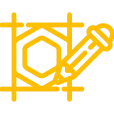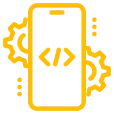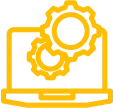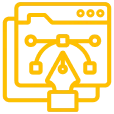Home Technologies Development Frameworks
Frameworks are the execution and effectiveness enablers of your web applications, web services and web development projects. With features like templates, session management and database access libraries, these frameworks supercharge your web experience. At TAV, we help businesses implement custom development frameworks that standardise coding practices and speed up project delivery. These foundation technologies allow teams to build consistent, scalable and maintainable applications.
Framework technologies provide reusable components that eliminate repetitive coding tasks. We design frameworks for your industry and technical environment. We focus on building architectures that support your long-term business goals while giving you immediate productivity gains.
Companies that implement custom frameworks see significant improvements in development speed, code quality and maintenance efficiency. We will guide you through framework selection, implementation and adoption so your organisation can realise these benefits across your application portfolio.



Expand your development capabilities with TAV’s comprehensive Framework solutions
We build proprietary frameworks tailored to your specific business domain and technical requirements. Our architects analyze your development patterns and create reusable structures that standardize common operations. Your teams gain productivity through consistent approaches to recurring challenges.

We establish model-view-controller patterns that separate business logic, data management, and user interface concerns. This architectural approach enables parallel development across specialized teams. Your applications maintain a clear separation of concerns for improved maintainability and testing.

Rapid application development thrives through Ruby on Rails’ convention-over-configuration philosophy and robust ecosystem. This mature framework accelerates web application delivery through integrated ORM, REST routing, and asset management. Projects benefit from established patterns that emphasize developer productivity and clean, maintainable code.

We configure and extend object-relational mapping frameworks that simplify database interactions within your applications. These frameworks eliminate repetitive SQL code and protect against injection vulnerabilities. Your developers focus on business logic instead of data access complexities.

We create standardized interfaces for service communication using modern REST principles and resource modeling. Our frameworks handle authentication, request validation, and response formatting consistently. Your services expose functionality through intuitive, well-documented endpoints that follow industry best practices.

We transform legacy applications to modern framework architectures through systematic component replacement. Our migration methodology preserves business logic while upgrading technical foundations. Your critical systems gain contemporary capabilities without risky complete rewrites.
Our Framework solutions address complex development challenges across industries
Leverage enterprise frameworks to transform your development practices

New team members become productive quickly through standardized coding patterns and comprehensive documentation. Onboarding processes focus on business knowledge rather than technical peculiarities. Organizations reduce productivity dips during team transitions and expansions.
Framework standards ensure technical decisions align with enterprise architecture principles across projects. Teams follow consistent approaches for security, performance, and integration concerns. Organizations avoid fragmented technologies that increase support complexity and maintenance costs.
Critical business algorithms and proprietary processes encapsulate within framework components with appropriate access controls. Sensitive logic remains protected even when working with external development partners. Organizations safeguard competitive advantages through architectural boundaries.
Legacy systems integrate with new technologies through framework adapters that bridge technological generations. Organizations evolve systems gradually without disruptive replacements. Business operations continue uninterrupted while technical foundations modernize systematically.
Project timelines become more reliable through consistent estimation models based on framework components. Teams complete similar functions in predictable timeframes across different applications. Organizations plan resources effectively with confidence in delivery schedules.
Applications built on internal frameworks reduce dependency on specific vendor technologies and roadmaps. Systems incorporate third-party components through abstraction layers that simplify future replacements. Organizations maintain negotiating leverage with technology providers through architectural flexibility.
TAV builds integrated Framework solutions tailored for organizational transformation
Years
Employees
Projects
Countries
Technology Stacks
Industries
TAV Tech Solutions has earned several awards and recognitions for our contribution to the industry
Successful framework implementation requires proper preparation and understanding of fundamental concepts. This guide walks through the essential first steps to establish a solid foundation for your development team. Following these practices helps avoid common pitfalls and accelerates your path to productivity with framework technologies.
Install required tools, including version control, IDE configurations, and package managers. Configure development environments with consistent settings across your team. Ensure all dependencies are properly versioned and documented for reproducible setups.
Explore the layered structure of modern frameworks, including data access, business logic, and presentation tiers. Learn how components interact through well-defined interfaces and dependency injection patterns. Identify extension points designed for customization without modifying core framework code.
Create a simple component following framework conventions for naming, structure, and integration. Follow step-by-step examples that demonstrate proper implementation patterns. Test your component in isolation before integrating with larger application structures.
Access comprehensive API references, architecture guides, and implementation examples. Contribute to documentation when extending framework functionality with custom components. Establish internal knowledge bases for organization-specific framework extensions and configurations.
Identify typical error patterns and their root causes in framework implementations. Utilize logging and debugging tools specific to your framework ecosystem. Follow established procedures for isolating issues between custom code and framework components.
Architecture defines the long-term success of your framework implementation. These best practices represent lessons learned across hundreds of successful projects and help establish patterns.
Implement strict boundaries between presentation, business logic, and data access layers. Enforce architectural rules through code reviews and automated analysis tools. Design components with single responsibilities to improve testability and maintenance.
Create extension points through interfaces, abstract classes, and dependency injection. Document customization approaches for different framework components. Build plugin architectures that allow functionality addition without core modifications.
Integrate authentication and authorization throughout framework architecture layers. Establish input validation patterns that prevent common vulnerability classes. Implement secure communication protocols between distributed framework components.
Externalize configuration from code using structured approaches for different environments. Implement secure storage for sensitive configuration values like credentials and keys. Design configuration inheritance patterns for shared settings across application instances.
Develop shared components that implement common business and technical functionality. Establish versioning strategies for component libraries as they evolve. Build comprehensive test suites that verify component behavior across different usage scenarios.
Quality assurance is critical for frameworks as they form the foundation of multiple applications across your organization. Implementing testing practices creates confidence in your framework and accelerates application development by reducing defects.
Configure continuous integration pipelines that run tests on every code change. Implement test environments that mirror production configurations. Establish code coverage metrics and quality gates for framework components.
Create focused tests that verify individual component behaviors in isolation. Implement mocking strategies for external dependencies and services. Establish naming conventions that identify test purposes and expected outcomes.
Verify interactions between framework components through targeted integration tests. Test configuration variations to ensure proper behavior across environments. Validate framework integration with external systems through appropriate test doubles.
Establish performance baselines for key framework operations under various load conditions. Implement automated performance tests that catch regressions before production deployment. Simulate different usage patterns to identify potential bottlenecks in framework components.
Implement static analysis tools that enforce coding standards across framework components. Establish pull request processes that include automated quality checks. Schedule regular code reviews focused on architectural alignment and design patterns.
Performance optimization ensures your framework delivers exceptional user experiences under real-world conditions. Here, we explore practical approaches to identifying and resolving performance bottlenecks across all framework layers.
Identify cacheable operations at different levels of the framework architecture. Implement appropriate caching technologies for data, computed results, and rendered output. Establish cache invalidation patterns that maintain data consistency while maximizing performance.
Implement efficient query patterns that minimize database round trips and resource usage. Utilized ORM features for batch operations and optimized data loading. Monitor and tune database access code for common performance anti-patterns.
Implement asset bundling and minification for framework-generated client resources. Optimize component rendering cycles to minimize unnecessary updates. Implement lazy loading patterns for modules and assets not required for initial rendering.
Monitor memory usage patterns across framework components during different operations. Implement resource pooling for expensive objects like database connections and service clients. Establish cleanup routines that prevent resource leaks during long-running operations.
Design stateless services that support horizontal scaling across multiple instances. Implement distributed caching for shared state in clustered environments. Configure load balancing strategies appropriate for different framework components.
Frameworks require ongoing attention to remain valuable assets for your organization over time. Following these practices ensures your framework meets emerging business needs.
Establish regular update cycles for framework components and dependencies. Assess compatibility impacts before upgrading core framework versions. Create migration plans that minimize disruption to ongoing development activities.
Identify framework components requiring refactoring through code metrics and analysis. Schedule regular maintenance sprints dedicated to technical improvements. Document architectural decisions and technical tradeoffs for future reference.
Communicate deprecation timelines before removing framework functionality. Provide migration paths and examples for updating dependent code. Maintain backward compatibility layers during transition periods.
Implement logging that provides visibility into framework operation and performance. Configure alerts for anomalous behavior in critical framework components. Collect usage metrics to identify heavily used and potentially problematic areas.
Create learning paths for new team members joining framework development. Document framework-specific patterns and practices unique to your implementation. Conduct regular knowledge-sharing sessions on framework architecture and evolution.
A development framework provides a structured foundation of reusable components, design patterns, and architectural guidelines for building applications. Frameworks accelerate development by eliminating repetitive coding tasks, establishing consistent practices, and providing proven solutions for common challenges.
The choice depends on your specific requirements. Ruby on Rails excels in rapid development and prototyping. Laravel offers excellent PHP-based solutions with elegant syntax. Custom frameworks provide tailored functionality for unique business needs. TAV assesses your technical environment, team skills, and project requirements to recommend the optimal approach.
Implementation timeframes vary based on complexity. Simple applications typically require 2-3 months, while enterprise solutions may take 4-6 months. Custom framework development may add 4-8 weeks to the initial phase. TAV’s accelerators and component libraries often reduce these timeframes by 30-40%.
Frameworks typically improve team productivity after an initial learning curve. Most developers adapt to established frameworks like Rails or Laravel within 2-4 weeks. Custom frameworks may require more training but offer long-term productivity gains. TAV provides comprehensive knowledge transfer and training programs to accelerate this transition.
Yes, many frameworks support mobile development through responsive web applications or hybrid mobile frameworks. Additionally, frameworks like React Native and Flutter provide framework approaches specifically for mobile. TAV helps implement appropriate framework architectures for your mobile requirements.
Modern frameworks are highly optimized and often perform comparably to custom solutions. Framework-based applications can outperform custom code through the implementation of proven optimization patterns. TAV’s performance tuning services ensure that framework solutions meet or exceed your performance requirements.
Framework maintenance follows structured approaches, including compatibility testing, phased implementations, and temporary backward compatibility layers. TAV implements automated testing to verify functionality during upgrades. Updates typically occur during predefined maintenance windows with minimal or zero downtime.
Frameworks implement security best practices, including protection against common vulnerabilities like SQL injection, cross-site scripting, and authentication exploits. TAV enhances these with additional security layers, including data encryption, session management, and access control frameworks tailored to your requirements.
Many popular frameworks like Ruby on Rails and Laravel are open-source with permissive MIT or similar licenses. Custom frameworks developed by TAV typically include perpetual usage rights. Our framework technology engagements include clear licensing documentation to ensure compliance and protect your interests.
Frameworks provide robust integration capabilities through standardized connectors, APIs, and data access layers. TAV implements custom integration components when required. Our framework architectures create abstraction layers that simplify connections to legacy systems, third-party services, and diverse database technologies.
Let’s connect and build innovative software solutions to unlock new revenue-earning opportunities for your venture









